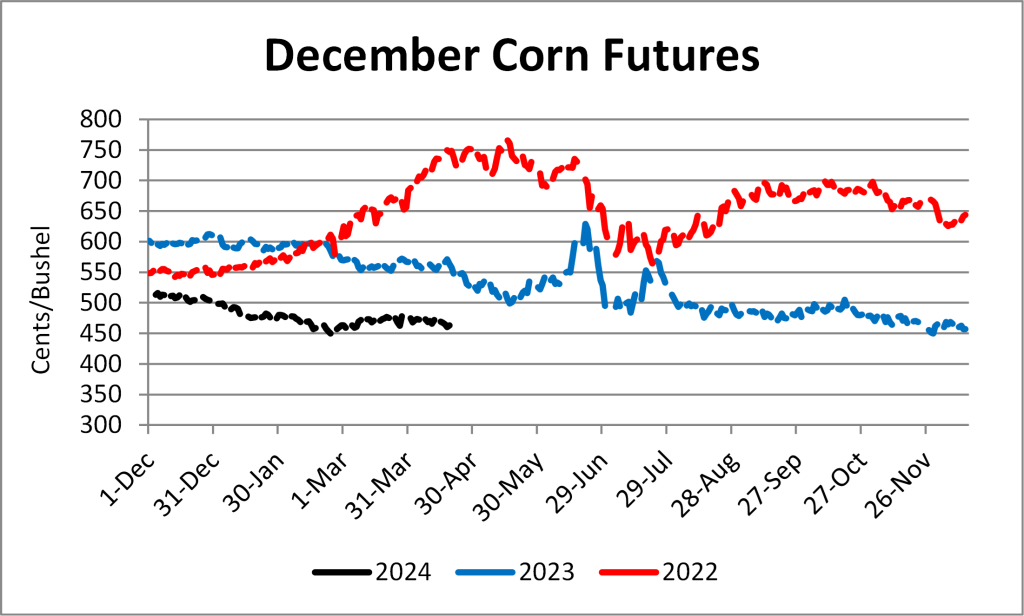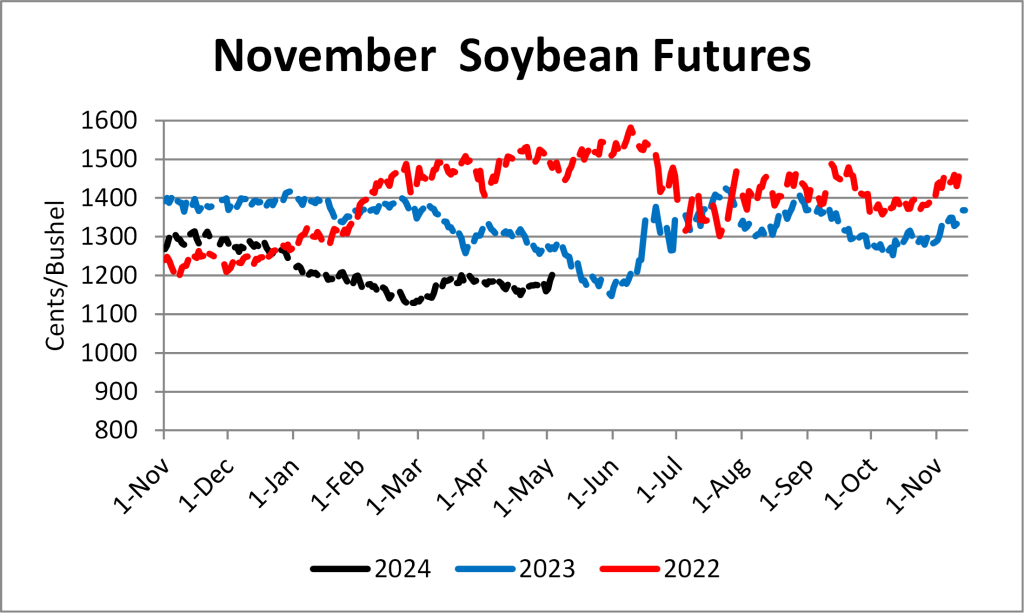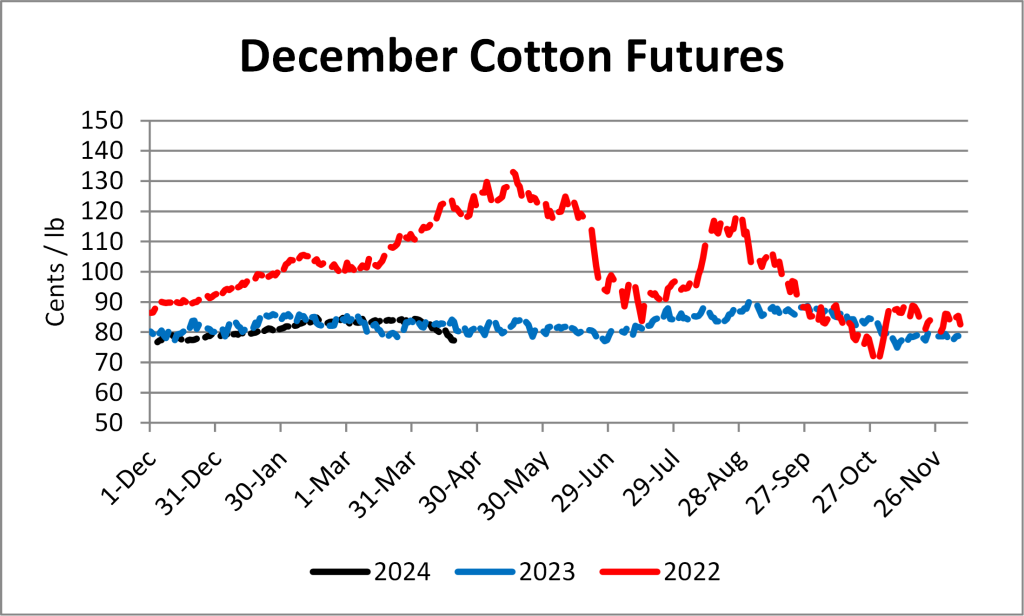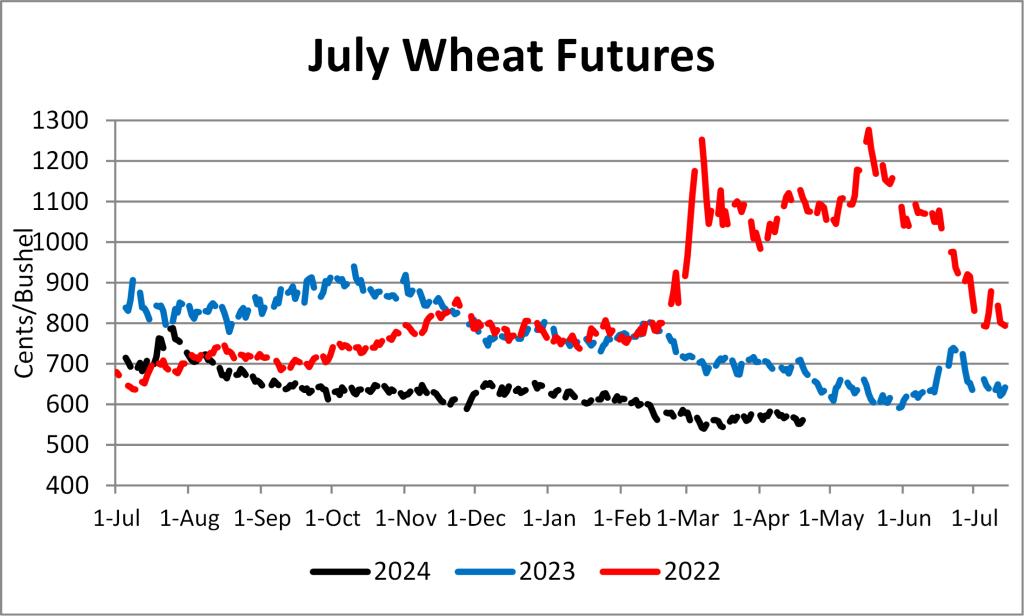by Charley Martinez, Farm Management Specialist
November 21, 2025
Overview
Soybeans and Wheat up for the week; Corn and Cotton down for the week
Last week ended with copious amounts of data with the re-opening of the government. This week, we got the crop progress report for the first time since late September. Most of the state has already harvested soybeans and corn, but the report indicates there is still a few acres in the state.
Throughout the week, various information pieces from private industry stakeholders got out in the news. One of note was that world soybean production was trimmed by 2 MMT according to International Grains Council data, with consumption rising 1 MMT and ending stocks down 2 MMT to 77 MMT. Additionally, USDA reported another 462,000 MT of soybeans sold to China via their daily announcement system on Wednesday morning. That followed the total 1.122 MMT between Monday and Tuesday, which took the total known sales to China to 1.812 MMT. The weekly FAS trade data was not released this week, most likely we will get it Monday next week, and it will be interesting to see what information is provided. My question is when will we get the data that was not released during the shutdown.
The weekly comments will not be going out next week, due to the holiday shorten week. Thus, Happy Thanksgiving to everyone. Additionally, UT Extension, in partnership with the Southern Extension Risk Management Education Program, Mid-America Farm Credit, UT Martin, and Simmons Bank, will be hosting two events December 1st. Topics covered will include:
- Vendor financing
- Debt carryover
- Consolidation loans
- Share and cash rental agreements
- Machinery costs and value
- Seed fertilizer and chemical costs
- Preparing financial statements
- Selecting crop insurance coverage
- Effective grain marketing and storage.
The first event will be hosted at 435 University Street in Martin, TN from 8AM-11AM December 1st. Breakfast will be provided.
The second event will be hosted at 605 Airways Blvd in Jackson, TN from 5PM-8PM December 1st. Dinner will be provided.
| Indicator | Previous | Current | Change |
|---|---|---|---|
| USD Index | 99.27 | 100.19 | 0.92 |
| Crude Oil | 59.83 | 57.88 | -1.95 |
| DJIA | 47174 | 46380 | -794 |
Corn
Across Tennessee, average corn basis (cash price-nearby futures price) strengthened from last week (third week in a row) at West, Northwest, West-Central, North-Central, and Mississippi River elevators and barge points. Overall, basis for the week ranged from 15 cents under to 25 cents over, with an average of 6 cents over with the December futures at elevators and barge points. Ethanol production for the week ending November 14 was 1.091 million barrels, up 16,000 barrels compared to the previous week. Ethanol stocks were 22.307 million barrels, up 88,000 barrels compared to last week. Cash prices ranged from $4.17 to $4.62 at elevators and barge points. December 2025 corn futures closed at $4.25, which is down 5 cents since last Friday. For the week, December 2025 corn futures traded between $4.24 and $4.38.
| Corn | Dec 25 | Change | Mar 26 | Change |
|---|---|---|---|---|
| Price | $4.25 | -$0.05 | $4.37 | -$0.07 |
| Support | $4.23 | -$0.02 | $4.35 | -$0.04 |
| Resistance | $4.27 | -$0.11 | $4.39 | -$0.13 |
| 20 Day MA | $4.31 | $0.01 | $4.45 | $0.02 |
| 50 Day MA | $4.25 | $0.01 | $4.40 | $0.00 |
| 100 Day MA | $4.19 | $0.00 | $4.35 | $0.00 |
| 4-Week High | $4.42 | $0.00 | $4.32 | $0.00 |
| 4-Week Low | $4.18 | $0.07 | $4.57 | $0.05 |
| Technical Trend | DOWN | = | DOWN | = |

Nationally, the Crop Progress report estimated corn harvested at 91% compared to 98% last year and a 5-year average of 94%. In Tennessee, corn harvested at 95% compared to 99% last year and a 5-year average of 99%. This week, new crop cash contracts ranged from $4.18 to $4.67 at elevators and barge points. March 2026 corn futures closed at $4.37, down 7 cents since last Friday.
Soybeans
Across Tennessee average soybean basis weakened compared to last week at West, Northwest, North-Central, West-Central, and Mississippi River elevators and barge points. Average basis ranged from 36 under to 18 over the January futures contract, with an average basis at the end of the week of 5 cents under. Cash soybean prices at elevators and barge points ranged from $10.88 to $11.70. January 2026 soybean futures closed at $11.25, up 1 cent since last Friday. For the week, January 2026 soybean futures traded between $11.13 and $11.69.
| Soybeans | Jan 26 | Change | Sep 26 | Change |
|---|---|---|---|---|
| Price | $11.25 | $0.01 | $11.12 | -$0.03 |
| Support | $11.16 | $0.03 | $11.07 | $11.07 |
| Resistance | $11.30 | -$0.13 | $11.15 | $11.15 |
| 20 Day MA | $11.23 | $0.21 | $11.11 | $11.11 |
| 50 Day MA | $10.73 | $0.09 | $10.83 | $10.83 |
| 100 Day MA | $10.57 | $0.04 | $10.72 | $10.72 |
| 4-Week High | $11.69 | $0.17 | $11.34 | $11.34 |
| 4-Week Low | $10.44 | -$0.76 | $10.64 | $10.64 |
| Technical Trend | UP | = | DOWN | = |

Nationally, the Crop Progress report estimated soybean soybeans harvested at 95% compared to 98% last year, and a 5-year average of 96%. In Tennessee, soybean harvested at 95% compared to 92% last year, and a 5-year average of 86%. September 2026 soybean futures closed at $11.12, down 3 cents since last Friday.
Cotton
North Delta upland cotton spot price quotes for November 20th were down to 61.74 cents/lb (41-4-34) and 66.49 cents/lb (31-3-35).
| Cotton | Dec 25 | Change | Mar 26 | Change |
|---|---|---|---|---|
| Price | 61.35 | -1.14 | 63.85 | -0.28 |
| Support | 60.54 | -1.37 | 63.32 | -0.37 |
| Resistance | 62.42 | -0.86 | 64.17 | -0.66 |
| 20 Day MA | 63.88 | -0.52 | 65.43 | -0.44 |
| 50 Day MA | 64.68 | -0.45 | 66.38 | -0.45 |
| 100 Day MA | 66.04 | -0.33 | 67.66 | -0.24 |
| 4-Week High | 66.10 | 0.00 | 67.57 | 0.00 |
| 4-Week Low | 60.79 | -1.34 | 63.11 | -0.85 |
| Technical Trend | DOWN | = | DOWN | = |

Nationally, the Crop Progress report estimated cotton harvested at 71% compared to 76% last year, and a 5-year average of 72%. In Tennessee, cotton harvested at 90% compared to 88% last year, and a 5-year average of 84%. December 2025 cotton futures closed at 61.35 cents, down 1.14 cents since last Friday. For the week, December 2025 cotton futures traded between 60.79 to 63.12 cents. Dec/Mar and Dec/May cotton futures spreads were 2.5 cents and 3.72 cents. March 2026 cotton futures closed at 63.85 cents, down .28 cents since last Friday. May 2026 cotton futures closed at 65.07 cents, down .28 cents since last Friday.
Wheat
Wheat cash prices at elevators and barge points ranged from $4.92 to $5.11.
| Wheat | Dec 25 | Change | Jul 26 | Change |
|---|---|---|---|---|
| Price | $5.27 | $0.03 | $5.57 | -$0.05 |
| Support | $5.22 | $0.03 | $5.53 | -$0.03 |
| Resistance | $5.32 | -$0.07 | $5.61 | -$0.13 |
| 20 Day MA | $5.35 | $0.07 | $5.69 | $0.05 |
| 50 Day MA | $5.21 | $0.01 | $5.59 | $0.01 |
| 100 Day MA | $5.31 | -$0.01 | $5.69 | -$0.02 |
| 4-Week High | $5.55 | $0.00 | $5.85 | $0.00 |
| 4-Week Low | $4.98 | $0.04 | $5.38 | $0.03 |
| Technical Trend | UP | = | DOWN | = |

Nationally, the Crop Progress report winter wheat planted at 92% compared to 94% last year, and a 5-year average of 95%; winter wheat emerged at 79% compared to 83% last year and a 5-year average of 84%; and winter wheat condition of very poor to poor at 19% (15% last year) and good to excellent at 45% (50% last year). December 2025 wheat futures closed at $5.27, up 3 cents since last Friday. December 2025 wheat futures traded between $5.22 and $5.50 this week. July 2026 wheat futures closed at $5.57, down 5 cents since than last Friday.
Additional Information
Links for data presented:
U.S. Export Sales – https://apps.fas.usda.gov/export-sales/esrd1.html
USDA FAS: Weekly Export Performance Indicator – https://apps.fas.usda.gov/esrquery/esrpi.aspx
EIA: Weekly ethanol Plant Production – https://www.eia.gov/dnav/pet/pet_pnp_wprode_s1_w.htm
EIA: Weekly Supply Estimates – https://www.eia.gov/dnav/pet/pet_sum_sndw_a_EPOOXE_sae_mbbl_w.htm
Upland Cotton Reports – https://www.fsa.usda.gov/FSA/epasReports?area=home&subject=ecpa&topic=fta-uc
Tennessee Crop Progress – https://www.nass.usda.gov/Statistics_by_State/Tennessee/Publications/Crop_Progress_&_Condition/
U.S. Crop Progress – http://usda.mannlib.cornell.edu/MannUsda/viewDocumentInfo.do?documentID=1048
USDA AMS: Market News – https://www.ams.usda.gov/market-news/search-market-news
If you would like further information or clarification on topics discussed in the crop comments section or would like to be added to our free email list please contact me at cmart113@utk.edu.